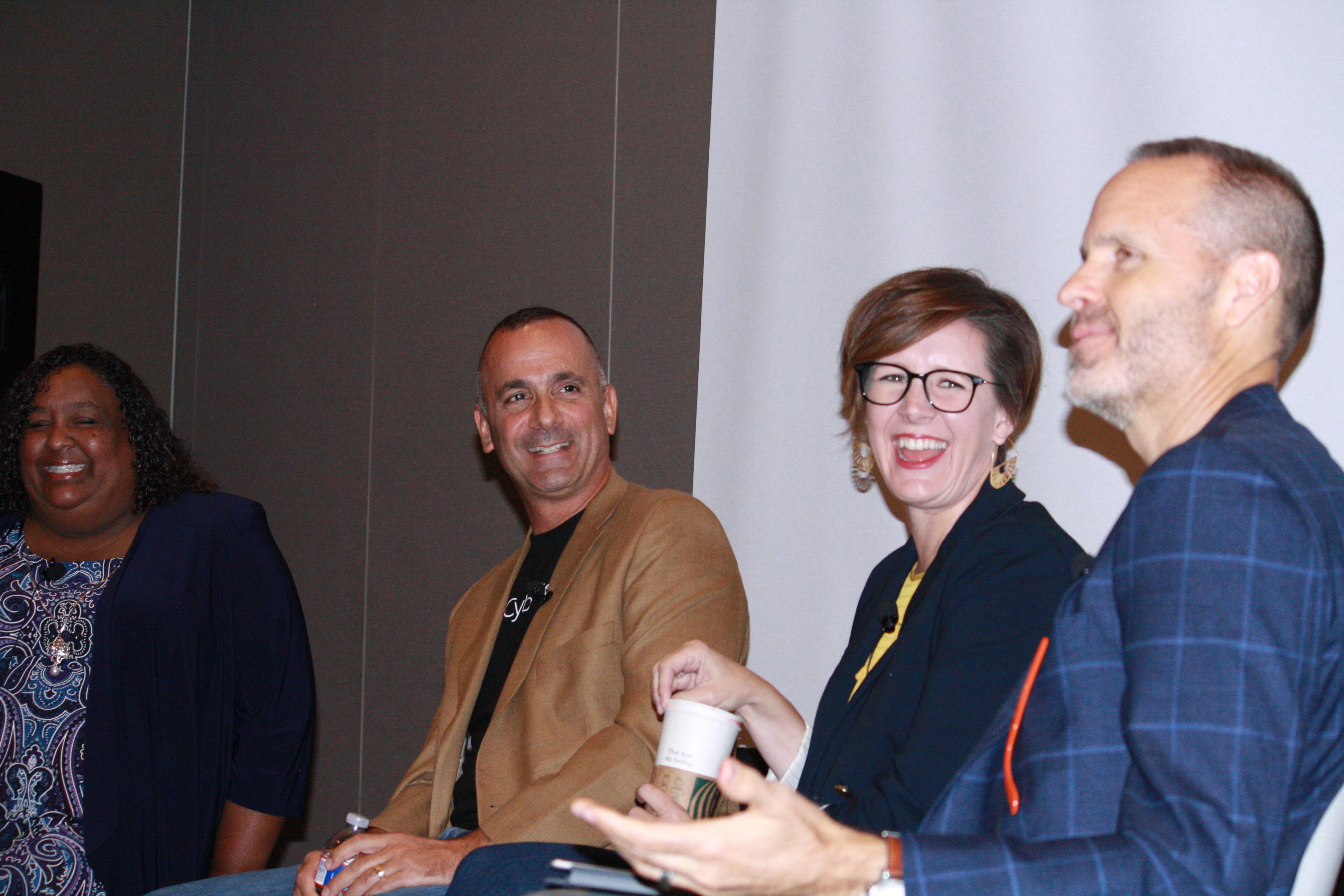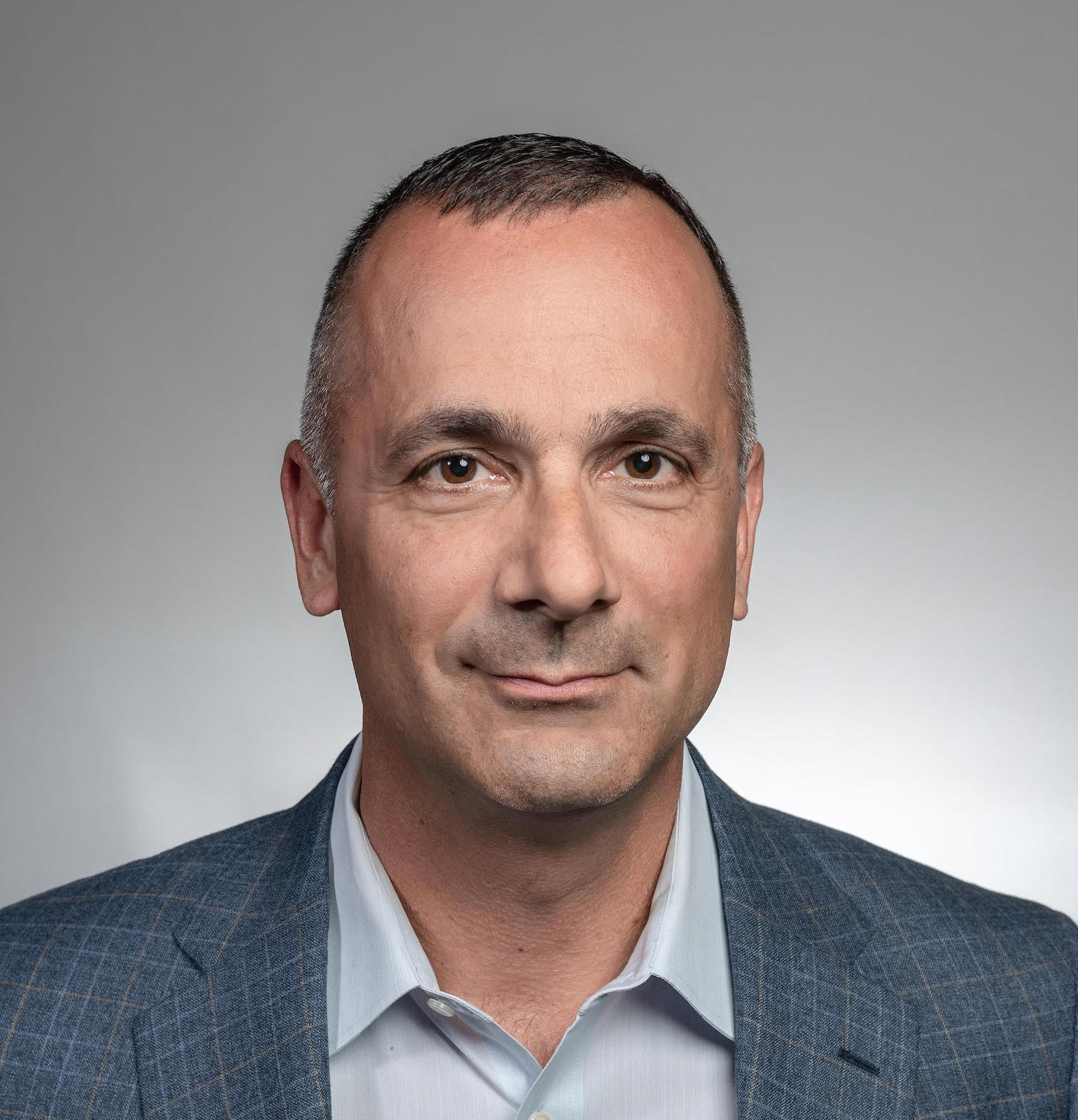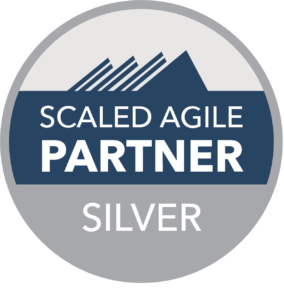In this panel at Keep Austin Agile, Erik Cottrell (CEO, Agile Velocity), Nicole Tanzillo (CO-Founder & COO, Ceresa), Ron Dovich (Assistant VP of Technology, AT&T Cybersecurity), and Amy Green-Hinojosa (VP, Project Management Office, Texas Mutual Insurance) shared an inside look into what it takes to convince leaders of Agile, the challenges and rewards of leading change, and the benefits they realized once they began to embrace agility. Read the full transcription below.

My name is Erik Cottrell, and I’m with Agile Velocity. It is an honor to be here with you today.
What we intended to do with this panel was to give folks a glimpse into what it’s like for leaders who are on an agility journey. We have the great fortune of working with some really great companies, and for me personally, I’ve worked with three of the finest people I know. They are on stage today, so we are going to allow them to tell their stories.
 My name is Nicole Tanzillo. I am the co-founder and COO of a company called Ceresa. We are based here in Austin, and we are focused on democratizing access to the best of the best in terms of leadership development through a technology platform. I’ll also be commenting from my past role. Most recently I spent eight years at Spiceworks, moving through a number of roles there, including pioneering our product operations function. That ultimately lead into business operations, where I was the VP on our executive team, leading some of our broader strategic functions and specifically our Agile transformation.
My name is Nicole Tanzillo. I am the co-founder and COO of a company called Ceresa. We are based here in Austin, and we are focused on democratizing access to the best of the best in terms of leadership development through a technology platform. I’ll also be commenting from my past role. Most recently I spent eight years at Spiceworks, moving through a number of roles there, including pioneering our product operations function. That ultimately lead into business operations, where I was the VP on our executive team, leading some of our broader strategic functions and specifically our Agile transformation.
 I’m Ron Dovich, AVP of Technology at AT&T Cybersecurity. We were AlienVault and got acquired about a year ago into AT&T. They formed a new cybersecurity unit as part of the acquisition, and I run the engineering team of about a hundred people. We focus on threat detection for businesses.
I’m Ron Dovich, AVP of Technology at AT&T Cybersecurity. We were AlienVault and got acquired about a year ago into AT&T. They formed a new cybersecurity unit as part of the acquisition, and I run the engineering team of about a hundred people. We focus on threat detection for businesses.
 My name is Amy Green-Hinojosa I work at Texas Mutual Insurance Company. We are the leading provider of workers comp insurance for the state of Texas. I am Vice President of Enterprise Program Management for the organization. We oversee all of the core initiatives of the company, and I had the pleasure of being the executive sponsor for our Agile transformation.
My name is Amy Green-Hinojosa I work at Texas Mutual Insurance Company. We are the leading provider of workers comp insurance for the state of Texas. I am Vice President of Enterprise Program Management for the organization. We oversee all of the core initiatives of the company, and I had the pleasure of being the executive sponsor for our Agile transformation.
Erik: What led to your decision to pursue agility?
Ron: We were in an Agile process, but we had really plateaued. Coming into the organization, we didn’t have much Agile experience at all. We got to a certain point and really struggled to get the team to move any further. We had a lot of problems with carry-over of stories from sprint to sprint, so we were not predictable at all. We had challenges in the organization even though the leaders were saying, “Hey, go do these things,” the team didn’t really know how to do them. We needed to help the teams so we said, “Hey, we need outside help.”
Nicole: Very similarly, what we were doing wasn’t working anymore. Our organization had gotten to the size of about a 100+ folks in the technical organization across engineering, product, design, IT, and devops.
We had recently rolled out product management, which was new for the organization, and we didn’t really change things with that new team so we were experiencing a lot of struggles. From a business perspective, [we, the leadership team,] felt like we were spending a lot of money on our technical organization but didn’t really know what we were getting. It didn’t feel like we were aligned on what we were supposed to be building.
On the flip side, the engineering organization was super frustrated. They felt like they were getting different direction and changing priorities from leadership constantly. They felt like they were having mounting technical debt, and felt like leadership wasn’t listening. There was a bunch of miscommunication and misalignment. We knew it wasn’t working, and we knew of this Agile thing that people say is great. So we decided to go see if it would work for us. It really it came down to the fact that we knew we had to do something because nobody was particularly happy with where we were at the time.
Amy: Our story is very similar. We were in the midst of some major legacy replacement, so we had projects that went on for 5 to 7 years. We tried to use some Agile techniques in those big projects, and when we came to the end of those, we looked at ourselves and said, “Well, that was fun.”
So, we thought we knew what were doing…but we really didn’t know what we were doing. We were just throwing around terms and ideas! But, we had a really neat group of people who did research and started a grassroots effort to push the company to embrace Agile. Some of those people are now moving into leadership positions in the organization…they became evangelists for Agile, and that’s what helped us decide to start our journey.
Erik: I think there’s a thread: things were broken, they weren’t working. Was there anything in particular that convinced you to say, “Yep, we know we need to go do something”?
Nicole: We knew we needed to change, but without an external inflection point, it can be hard to pull the trigger. For us, we had a change in leadership in the engineering organization and an opening to new ideas. That was the tipping point that helped us say “OK, it’s time to make some changes.” It’s not that anything fundamentally changed, we didn’t have any more information than we had the day before, but we had momentum in the organization to do it.
Ron: For me, it was that nobody was happy. Management wasn’t happy, the teams weren’t happy. We needed to change something.
Erik: One of the things I think is interesting is that leaders have to work in teams as well. So Ron, this question is for you. How did you convince your colleagues and leadership at AlienVault (AT&T Cybersecurity) to get on board?
Ron: We thought a lot about it, and we were trying to figure out how to get past the plateau that we were at. We were batting around different ideas, and I had heard of Agile Velocity here a couple years ago so I said “Let’s bring in David.”
David [Hawks] came in for a 2-hour workshop with my team and drove home a lot of points and pushed on us really hard in those two hours. Walking in, everyone had different ideas about what we should do but walking out, we all knew what we needed to go do.
Erik: Question in terms of that same convincing thing… Amy, what did your boss think?
Amy: I had a unique situation. I had two bosses that the time. I had our CIO who was really happy with the way things were going and didn’t really see that there was a need for change. But we had a new COO, Jeanette Ward, who really embraced this and was very excited for the things that she was hearing out in the industry and in journals. She was 150% supportive of this–so, we had to walk the line of pleasing her but also helping bring that CIO along.
We had to work through some of the processes and get a few little wins under our belt, and eventually, before he retired, he was supportive of our Agile journey and understood the need for it. But, it wasn’t easy to convince somebody who’d been in the IT industry for 40 years that the way we were doing it before wasn’t going to work in this new world.
Erik: I’m going to dig a little deeper on that one… so, were there specific things that gave that person comfort or confidence that it was okay to keep going down that path? Is there anything that comes to mind that helped them see a different way?
Amy: Their peers. The other C-suite people in the organization started seeing positive change. He also saw his direct reports really embrace this and come together as a strong team–and that had not necessarily been the case before. But through the transformation, he saw a really good team come together and be able to execute good things.
Erik: Change is almost always disruptive, in some way shape or form. Nicole, looking back now that you’ve changed roles and companies, you have very different hindsight. So, how was this transformation different than yours?
Nicole: I think if I separate my expectations from the organization’s expectations that will help too.
It was pretty clear upfront that we had a road to walk down in terms of change. We had 100+ people who were going to be doing this day-to-day. I think the biggest challenge for us was that we had “buy-in” from executive leadership to make [the transformation] happen, but not necessarily real understanding as to what that really meant. So, for us, if I had to go back and think about what I would do differently, it would have been spending more time with them, and really having them walk down the path with us and push it. It’s really easy to let schedules dictate them being involved or not, which makes a lot of sense. But I think we would have ended up where we wanted to be a little faster had we done that.
As I look back, I’m really glad we did it the way we did it. For us, the decision wasn’t whether we are going to do it or not. It was, “Are we going to do it ourselves or are we going to bring in somebody from the outside?” Because we like to do things ourselves–and that was a really big challenge for us.
Those of you considering it, there are two things that made me really glad we did. It helped to have somebody that could see the blind spots that we couldn’t see. We were so in it, we didn’t know what we didn’t know–both at a day-to-day implementation and at a leadership level. The other thing is something that I learned in this process that is applied at a lot of different areas: it matters who the message is coming from. I can read a book and figure stuff out–I’m a pretty smart person. I’ve got these skills but the entire engineering organization was not going to listen to me tell them how to do this because I’m not the right person to give this message. I don’t have all the expertise. And for me, finding those experts–whether they were internal or external–to help me champion it was a really big deal. It couldn’t just be about me championing. I had to bring in folks who could champion it for me, in the right ways.
Amy: We, historically, as an organization, are about doing it ourselves. Bringing in outside expertise has not been a part of our culture. This was one of the first times that we brought someone in to really help us see the blind spots. We’re really good at what we do both on the insurance and the technology side, so we have a level of arrogance–that we earned! But to have someone come in and tell us, “You’re good, but you’re not as good as you think, and here’s where you need to focus,” was so powerful. We would have missed the mark completely if we had not had someone there to help us through those things.
Ron: For me the biggest thing was, I thought they would help us with processes, but that’s such a small piece of it. It’s the people, the soft skills, the communication problems, the collaboration, relinquishing the command and control that we were doing as leaders–telling people what to do and not letting the people come with their best ideas–that was the biggest unexpected part for me.
Amy: It’s painful in the middle of your transformation when your teams say, “You are the impediment. You need to change this.” You cannot lead in the same way.
Nicole: That’s one of the things we also saw. As the teams were rising up and having more initiative, they had to wait on us. They were looking to us for context to make localized decisions that would make sense in the context of the broader organization. And we weren’t doing our jobs–we wouldn’t tell them. They’d make decisions, and we would have to go back to correct stuff–everyone was mad. It put a lot more ownership on us to put in the work up front and set up those frameworks so they could just go. We didn’t understand that right out the gate, that this would really impact how leadership behaves.
Audience member: When you give up control, you’re giving up power. You guys seem to have handled it pretty well. What advice do you have for other leaders? In enterprises, it’s all about control. Span and scope means power–how do you manage giving up power?
Ron: Leaders also need coaching. We need help. We get to a certain point in our careers where we think we got this, but we really don’t and our people see through it. So, you have to get somebody to help you drill into an issue and really figure out why you’re having that issue and what the root of the problem is–most of us are pretty poor at that. You don’t just bring in people and have them fix your teams, you have to help yourself along the way.
Nicole: One of the things I read in Turn The Ship Around is that relinquishing control is so fear-based. Anyone else type A? I suffer from that disease, and it’s really hard. We don’t scale as leaders if we keep holding on to things, and Erik is still teaching me that lesson everyday. One of the great things they talk about in that book is how are you pushing that down in a way that you can be confident it’s going to work–a leaders job is about creating and testing competency in your people. It is on us to not just give it to them but to think about the mechanisms in place to certify that competency so they are able to make decisions. So for me it’s about starting to develop those frameworks and processes so that I can release control.
Amy: Baby steps. Small wins that begin to tell the story that it’s okay to let power go.
Erik: One of the things that often happens, is we forget the fact that you have to give before you can get. Leaders have a tough job. A lot of people come to them asking and taking, no one is coming to them giving. As people seeking to drive change, we have to remember their goals are not our goals and we need to get our goals aligned to their goals and treat them with the same kind of respect we’re asking for.
Nicole: What the transformation has been about for us is much more about how people work together, how we communicate, how we prioritize, how to make decisions, and far less about how everything is set up mechanically.
Erik: Let’s talk about the benefits. What was the best part about your transformation?
Ron: For me, it is when the team started to come back and ask for things from us. Before, leadership was telling everybody what to go do. Suddenly the teams started coming to us saying what they need and why they need it. Which meant we were finally working together towards the same goals.
Amy: The first time the teams started coming back with the most amazing solutions that nobody thought was possible and started asking the why’s: “How come we can’t do that?” and “Can we do that?” was amazing to see. We’re only 19 months into our transformation but our teams are already developing things that no engineer was thinking about a year or two years ago.
Nicole: Pretty quickly, I saw that once we got out of the bottom of the change curve, the energy fundamentally changed. There’s something about having things on the wall, having standups, and operating differently that they were able to take ownership in a way they never had the context to do well before. It was exciting and felt good to be around.
Erik: One of the things that we often run up against is culture. How has your culture been impacted?
Amy: Our culture has changed significantly. We are a good place to work. We were voted one of the best places to work in Texas. But within IT, we were very siloed. Teams didn’t interact with each other, and we didn’t interact as much with our onsite business customers.
But, now what you see is that buzz and energy. Everybody is really focused on collaboration and tackling things together. People that never spoke to each other before or interact with each other are working together. Once people got empowered and were given freedom in their abilities to work, it changed from a happy, positive place to this energetic, exciting place to be.
It hasn’t been all rainbows and unicorns because while people ask for empowerment and freedom, there is responsibility that comes with that. Transitioning and helping teams understand that they are responsible and accountable for things they didn’t have to worry about before caused some stress. But, I think they’re coming around to that. Now that they understand that we’ve put frameworks and guardrails in place, the technology group at Texas Mutual is a better, more energetic environment.
Ron: We’re till pretty early in our transformation, only about 8 or 9 months in. It hasn’t changed our culture yet, but we are in transition.
Nicole: It helped uncover issues in our culture. It is hard to hide stuff in this model. Right away when we were first doing some workshops, we identified some divas who were used to working in a very isolated way and perhaps not treating their colleagues super well because they were so amazing at what they did. That doesn’t fly so well in this model.
So, it created some really hard choices for the leadership team right away, because we had to decide if we allow this one person to continue to do their own thing or if we say this person is not a fit for the organization that we’re building. In some cases, they figured it out and others don’t work there anymore because it just wasn’t aligned with where we were going. You gotta engage.
Amy: It’s a drastic change going from individual contributors, getting kudos to focusing on the team where everybody is scored the same and it is a team success. There are no more superheroes and the playing field becomes level.
Erik: One of the things that I noticed at Texas Mutual: There is a team that had an area [in the office] and outside of it there was a sign that said “Success on delivering on our last commitment”. Beneath this sign, they had a picture of a thumb that you can turn up or down. For the next sprint the thumb was turned down. They were broadcasting to the entire company that they did not meet their commitment.
I told the CIO that they don’t have to manage that team anymore. They are self-managing, holding themselves accountable.
Audience member: We’ve talked about teams and individuals, but how did this process change you? How did it impact you as a leader?
Amy: It made us hold a mirror up to ourselves as a leader and say, “What does this new world mean to me?” and, “Do I even want to be a leader in this new world?” or, “Am I willing to make that kind of change?”
You have to look at yourself and make a real, deliberate choice to lead differently.
Nicole: I grew as much or more than the organization did in this process. There were a lot of moments where I was freaking out. We were asking really big questions that I didn’t have the answers to, and wasn’t sure how we are going to get there with our leadership team. It’s that battle of, “How do I do the work that puts the team first and offers what they need out of me?”
That’s exhausting: slowing down and being thoughtful before I go into a conversation, thinking about what they need from me. Because it’s not about what I have, it’s about what they need.
Ron: It’s re-energized me. You can do these jobs for years and get good at it, but am I really being strategic. This will make you question what you are getting done and what your priorities are. Now you have to spend more time being thoughtful instead of just blowing through things.
Erik: How do you work with your partners on the business side to get them to see what you’re about to do?
Amy: One of the things that we did when we decided to go on the journey, was put together an Agile Leadership Team of people to help guide the journey. We went and asked our executive leadership if we could have some people from our business unit be a part of that.
We didn’t get a whole lot of people, but we got enough and converted some to evangelize Agile to the business. It was really important to have the voice of our business counterparts be a part of the transformation. IT can stand up all day long and talk about benefits, but if the business side it not part of that journey, it’s really hard for them to understand. We also checked in a lot with our business leadership people, and gave them Agile updates every week. We forced them along with our journey.
Nicole: We got away from talking about the features and stuff we were doing to what we were trying to do for the business. We were able to connect by shifting our goals and communication to be around the outcomes we were trying to achieve. We were speaking their language and that was a big shift for us. It moved us from being an activity-based organization to an outcome-based organization.
Ron: We’re not there. We’re siloed from the rest of the business–and by business, I don’t mean AT&T, I mean the threat detection and response piece of the Cybersecurity unit–the rest of the business unit around us thinks Agile is an engineering thing.
Erik’s Advice: Banish every bit of jargon. Don’t use the word Agile–Agility doesn’t count [as jargon]. Try and have a conversation. It’s all about working together. Are we clear about what we are trying to do, do we communicate well, do we fight well? Banishing the jargon is a good exercise because it helps us think about what are we trying to do together.
Audience member: How did you work through the need to be there at all times and fully informed of all details?
Ron: I’m still working on it. As our organization continues to grow, you just can’t. You have to be comfortable relying on other people. It’s a struggle because when someone asks a question you want to know the answer, but I often don’t.
Audience member: How do you handle it when someone wants to be the answer person?
Nicole: If we democratize access to the data, then everyone can validate, verify, and provide that data as well. So, the more we can get away from only one person being able to access the data, the better.
Amy: That is the journey we are on right now, getting that visibility so anybody can self service the information they need about the work that is getting done.
Erik: I challenge you to step back, because this person is doing this for a reason–it gives them a sense of value. When you take a step back, you realize this person just needs love and validation. [Sometimes, a little sympathy and conversation can work wonders.]Final words of wisdom:
Ron: Get yourself a coach. Could be a mentor–just someone who is willing to ask you tough questions. It has been life changing for me.
Nicole: It’s not just about us. Lebron has a coach. The US Women’s Soccer Team has a coach. These are world class people doing world class things, and they still have coaches because none of us can see the blind spots. Having someone who is objective both for us as leadership and for your team is important.
One of the biggest mistakes we almost made was not having Agile team coaches. Everyone thought that they were going to be a Scrum Master who would take notes and schedule meetings. But that is so far from the truth. This idea of having a coaching mindset in an organization is transformative but you have to have enough of them and support for them for it to take hold.
Amy: Build internal coaches. Because when the external coaches leave, you still have that coaching capability in your organization–and you will need it.
 Scaled Agile Framework or SAFe® is the most popular and far-reaching of the Agile scaling frameworks out there. But before you make the decision to go all-in with this popular framework, it’s important to know the facts. Here are 4 busted myths about SAFe.
Scaled Agile Framework or SAFe® is the most popular and far-reaching of the Agile scaling frameworks out there. But before you make the decision to go all-in with this popular framework, it’s important to know the facts. Here are 4 busted myths about SAFe.
 We are excited to join Scaled Agile’s Partner program. This worldwide network includes transf
We are excited to join Scaled Agile’s Partner program. This worldwide network includes transf Agile transformations can do wonders for organizations across the board. Agile helps teams to continuously improve while focusing on attainable goals and timely delivery. However, implementing Agile across a large organization comes with its own challenges. Businesses that want to scale Agile across multiple departments have a range of Agile frameworks to consider to help them combat these challenges, and some might work better for their organizations than others.
Agile transformations can do wonders for organizations across the board. Agile helps teams to continuously improve while focusing on attainable goals and timely delivery. However, implementing Agile across a large organization comes with its own challenges. Businesses that want to scale Agile across multiple departments have a range of Agile frameworks to consider to help them combat these challenges, and some might work better for their organizations than others.

 In the previous article in this series, I covered the first antidote to the Zombie Agility contagion,
In the previous article in this series, I covered the first antidote to the Zombie Agility contagion, 

 My name is Nicole Tanzillo. I am the co-founder and COO of a company called Ceresa. We are based here in Austin, and we are focused on democratizing access to the best of the best in terms of leadership development through a technology platform. I’ll also be commenting from my past role. Most recently I spent eight years at Spiceworks, moving through a number of roles there, including pioneering our product operations function. That ultimately lead into business operations, where I was the VP on our executive team, leading some of our broader strategic functions and specifically our Agile transformation.
My name is Nicole Tanzillo. I am the co-founder and COO of a company called Ceresa. We are based here in Austin, and we are focused on democratizing access to the best of the best in terms of leadership development through a technology platform. I’ll also be commenting from my past role. Most recently I spent eight years at Spiceworks, moving through a number of roles there, including pioneering our product operations function. That ultimately lead into business operations, where I was the VP on our executive team, leading some of our broader strategic functions and specifically our Agile transformation. I’m Ron Dovich, AVP of Technology at AT&T Cybersecurity. We were AlienVault and got acquired about a year ago into AT&T. They formed a new cybersecurity unit as part of the acquisition, and I run the engineering team of about a hundred people. We focus on threat detection for businesses.
I’m Ron Dovich, AVP of Technology at AT&T Cybersecurity. We were AlienVault and got acquired about a year ago into AT&T. They formed a new cybersecurity unit as part of the acquisition, and I run the engineering team of about a hundred people. We focus on threat detection for businesses.